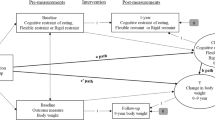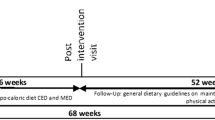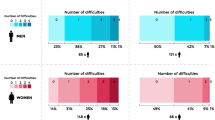Abstract
OBJECTIVE: This study was performed to examine changes in eating behaviors as assessed by the three-factor eating questionnaire (TFEQ) and to quantify the potential associations between these eating behaviors and body weight changes in a 6-follow-up study.
DESIGN AND SUBJECTS: Prospective study performed in men and women who were tested twice (Visit 1=1989–1995 and Visit 2=6 y later) in the Québec Family Study (QFS).
RESULTS: Women were more restrained and less hungry than men. To reduce food intake, women relied more on strategic dieting behavior and avoided more fattening food. However, they had higher emotional and situational susceptibility to eat than men. Significant decreases in the disinhibition score were noted over time in women (P<0.01), which resulted from a decrease in habitual susceptibility behavior to increase food intake. In men, we observed an increase in the avoidance of fattening food (P<0.05). In both genders, we found that the 6-y change in restraint behavior was negatively correlated with body weight changes (P<0.05). In women, a high restraint behavior seems to promote weight gain, whereas in men, it is associated with the opposite trend.
CONCLUSION: These results suggest that variables reflecting some eating behaviors are associated with body weight changes in a free-living context. However, these behaviors are expressed differently between men and women. These behaviors should be considered in clinical interventions for individuals seeking a better body weight control.
This is a preview of subscription content, access via your institution
Access options
Subscribe to this journal
Receive 12 print issues and online access
$259.00 per year
only $21.58 per issue
Buy this article
- Purchase on Springer Link
- Instant access to full article PDF
Prices may be subject to local taxes which are calculated during checkout
Similar content being viewed by others
References
Laessle RG, Tuschl RJ, Kotthaus BC, Pirke KM . A comparison of the validity of three scales for the assessment of dietary restraint. J Abnorm Psychol 1989; 98: 504–507.
Tuschl RJ . From dietary restraint to binge eating: some theoretical considerations. Appetite 1990; 14: 105–109.
Westerterp-Plantenga MS, Wouters L, ten Hoor F . Restrained eating, obesity, and cumulative food intake curves during four-course meals. Appetite 1991; 16: 149–158.
Westenhoefer J, Stunkard AJ, Pudel V . Validation of the flexible and rigid control dimensions of dietary restraint. Int J Eat Disord 1999; 26: 53–64.
McGuire MT, Jeffery RW, French SA, Hannan PJ . The relationship between restraint and weight and weight-related behaviors among individuals in a community weight gain prevention trial. Int J Obes Relat Metab Disord 2001; 25: 574–580.
Westenhoefer J . Dietary restraint and disinhibition: is restraint a homogeneous construct? Appetite 1991; 16: 45–55.
Williamson DA, Lawson OJ, Brooks ER, Wozniak PJ, Ryan DH, Bray GA, Duchmann EG . Association of body mass with dietary restraint and disinhibition. Appetite 1995; 25: 31–41.
Tuschl RJ, Platte P, Laessle RG, Stichler W, Pirke KM . Energy expenditure and everyday eating behavior in healthy young women. Am J Clin Nutr 1990; 52: 81–86.
Polivy J, Herman CP . Distress and eating: why do dieters overeat? Int J Eat Disord 1999; 26: 153–164.
Bellisle F, Dalix AM . Cognitive restraint can be offset by distraction, leading to increased meal intake in women. Am J Clin Nutr 2001; 74: 197–200.
Wardle J, Steptoe A, Oliver G, Lipsey Z . Stress, dietary restraint and food intake. J Psychosom Res 2000; 48: 195–202.
Stunkard AJ, Messick S . The three-factor eating questionnaire to measure dietary restraint, disinhibition and hunger. J Psychosom Res 1985; 29: 71–83.
Lawson OJ, Williamson DA, Champagne CM, DeLany JP, Brooks ER, Howat PM, Wozniak PJ, Bray GA, Ryan DH . The association of body weight, dietary intake, and energy expenditure with dietary restraint and disinhibition. Obes Res 1995; 3: 153–161.
LaPorte DJ, Stunkard AJ . Predicting attrition and adherence to a very low calorie diet: a prospective investigation of the eating inventory. Int J Obes Relat Metab Disord 1990; 14: 197–206.
Pekkarinen T, Takala I, Mustajoki P . Two year maintenance of weight loss after a VLCD and behavioural therapy for obesity: correlation to the scores of questionnaires measuring eating behaviour. Int J Obes Relat Metab Disord 1996; 20: 332–337.
Wadden TA, Berkowitz RI, Vogt RA, Steen SN, Stunkard AJ, Foster GD . Lifestyle modification in the pharmacologic treatment of obesity: a pilot investigation of a potential primary care approach. Obes Res 1997; 5: 218–226.
Bjorvell H, Aly A, Langius A, Nordstrom G . Indicators of changes in weight and eating behaviour in severely obese patients treated in a nursing behavioural program. Int J Obes Relat Metab Disord 1994; 18: 521–525.
Karlsson J, Hallgren P, Kral J, Lindroos AK, Sjostrom L, Sullivan M . Predictors and effects of long-term dieting on mental well-being and weight loss in obese women. Appetite 1994; 23: 15–26.
Kiernan M, King AC, Stefanick ML, Killen JD . Men gain additional psychological benefits by adding exercise to a weight-loss program. Obes Res 2001; 9: 770–777.
Foster GD, Wadden TA, Swain RM, Stunkard AJ, Platte P, Vogt RA . The eating inventory in obese women: clinical correlates and relationship to weight loss. Int J Obes Relat Metab Disord 1998; 22: 778–785.
Clark MM, Marcus BH, Pera V, Niaura RS . Changes in eating inventory scores following obesity treatment. Int J Eat Disord 1994; 15: 401–405.
Westerterp-Plantenga MS, Kempen KP, Saris WH . Determinants of weight maintenance in women after diet-induced weight reduction. Int J Obes Relat Metab Disord 1998; 22: 1–6.
Westerterp-Plantenga MS, Wijckmans-Duijsens NE, Verboeket-van de Venne WP, de Graaf K, van het Hof KH, Weststrate JA . Energy intake and body weight effects of six months reduced or full fat diets, as a function of dietary restraint. Int J Obes Relat Metab Disord 1998; 22: 14–22.
Hays NP, Bathalon GP, McCrory MA, Roubenoff R, Lipman R, Roberts SB . Eating behavior correlates of adult weight gain and obesity in healthy women aged 55–65 y. Am J Clin Nutr 2002; 75: 476–483.
Bond MJ, McDowell AJ, Wilkinson JY . The measurement of dietary restraint, disinhibition and hunger: an examination of the factor structure of the Three Factor Eating Questionnaire (TFEQ). Int J Obes Relat Metab Disord 2001; 25: 900–906.
Lohman T, Roche A, Matorel R (eds). The Airlie (VA) consensus, standardization of anthropometric measurements. Human Kenetics Publishers: Champaign IL; 1988. pp 39–80.
Siri WE . The gross composition of the body. Ad Biol Med Physiol 1956; 4: 239–280.
Tremblay A, Sévigny J, Leblanc C, Bouchard C . The reproducibility of a three-day dietary record. Nutr Res 1983; 3: 819–830.
Verdier P, Beare-Rodgers JL . The Canadian nutrient file. J Can Diet Assoc 1984; 45: 52–55.
Bouchard C, Tremblay A, Leblanc C, Lortie G, Savard R, Thériault G . A method to assess energy expenditure in children and adults. Am J Clin Nutr 1983; 37: 461–467.
Lluch A . Identification des conduites alimentaires par approches nutritionnelles et psychométriques: implications thérapeutiques et préventis dans l'obésité humaine (Identification of food intake behaviors by nutritional and psychometric means: implications for prevention and treatment of human obesity), Nancy I. Université Henri Poincaré: France; 1995.
de Castro JM . The relationship of cognitive restraint to the spontaneous food and fluid intake of free-living humans. Physiol Behav 1995; 57: 287–295.
Lindroos AK, Lissner L, Mathiassen ME, Karlsson J, Sullivan M, Bengtsson C, Sjostrom L . Dietary intake in relation to restrained eating, disinhibition, and hunger in obese and nonobese Swedish women. Obes Res 1997; 5: 175–182.
Neumark-Sztainer D, Sherwood NE, French SA, Jeffery RW . Weight control behaviors among adult men and women: cause for concern? Obes Res 1999; 7: 179–188.
Statistics Canada. How healthy are Canadians? The health divide— How the sexes differ. Health Report, 2001. p 11–21.
Rizvi SL, Stice E, Agras WS . Natural history of disordered eating attitudes and behaviors over a 6-year period. Int J Eat Disord 1999; 26: 406–413.
Pasman WJ, Saris WH, Westerterp-Plantenga MS . Predictors of weight maintenance. Obes Res 1999; 7: 43–50.
McLean JA, Barr SI, Prior JC . Cognitive dietary restraint is associated with higher urinary cortisol excretion in healthy premenopausal women. Am J Clin Nutr 2001; 73: 7–12.
Barr SI, Prior JC, Vigna YM . Restrained eating and ovulatory disturbances: possible implications for bone health. Am J Clin Nutr 1994; 59: 92–97.
Van Loan MD, Keim NL . Influence of cognitive eating restraint on total-body measurements of bone mineral density and bone mineral content in premenopausal women aged 18–45 y: a cross-sectional study. Am J Clin Nutr 2000; 72: 837–843.
Acknowledgements
This study was supported by the Canadian Institutes of Health Research. We express our gratitude to L Allard, G Fournier and C Leblanc for their help in the collection and analysis of the data.
Author information
Authors and Affiliations
Corresponding author
Rights and permissions
About this article
Cite this article
Drapeau, V., Provencher, V., Lemieux, S. et al. Do 6-y changes in eating behaviors predict changes in body weight? Results from the Québec Family Study. Int J Obes 27, 808–814 (2003). https://doi.org/10.1038/sj.ijo.0802303
Received:
Revised:
Accepted:
Published:
Issue Date:
DOI: https://doi.org/10.1038/sj.ijo.0802303
Keywords
This article is cited by
-
Interplay between adipose tissue secreted proteins, eating behavior and obesity
European Journal of Nutrition (2022)
-
Appetite disinhibition rather than hunger explains genetic effects on adult BMI trajectory
International Journal of Obesity (2021)
-
Self-Compassion, Internalized Weight Stigma, Psychological Well-Being, and Eating Behaviors in Women
Mindfulness (2021)
-
How dieting might make some fatter: modeling weight cycling toward obesity from a perspective of body composition autoregulation
International Journal of Obesity (2020)
-
The Three-Factor Eating Questionnaire-R21: a confirmatory factor analysis in a Portuguese sample
Eating and Weight Disorders - Studies on Anorexia, Bulimia and Obesity (2020)



